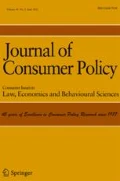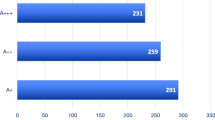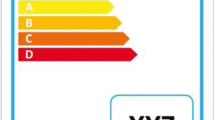Abstract
Energy labels are one of the most widely used policies in the European Union for increasing the energy efficiency of household appliances. However, their effectiveness in promoting energy-efficient purchases has sometimes been called into question. One of the reasons for this is that consumers may have difficulties in fully understanding the energy consumption information provided on labels (in kilowatt-hour per year). Some authors argue that to avoid this problem energy consumption information should be converted into monetary information. We analyse whether providing monetary information on lifetime energy savings can significantly increase purchases of energy-efficient appliances. To that end, a field experiment was carried out with small retailers in Spain. The experiment involved three types of appliances: washing machines, fridges and dishwashers. The impact of monetary information on actual purchases of appliances was tested in different ways: (i) by including a monetary label to display energy savings during the lifetime of the product; (ii) by the monetary information provided by sales staff; and (iii) by combining (i) and (ii). We find that the effectiveness of providing monetary information depends on the appliance and the specific way in which the information is provided. For washing machines, providing monetary information through a monetary label seems effective in promoting the purchase of highly energy-efficient appliances. However, for fridges, both monetary information provided by staff alone and the combination of the monetary label and information from sales staff seem to be effective in promoting purchases of A+++ fridges. Surprisingly, no effect is found for dishwashers.



Similar content being viewed by others
Notes
Red Eléctrica Española publishes all the data for PVPC (Precio Voluntario para el Pequeño Consumidor – Voluntary Price for Small-scale Consumers) on the Spanish market on this website: https://www.esios.ree.es/es/pvpc. We chose the highest energy price recorded because it was closer to the real price that consumers were paying
To measure the energy consumption of an appliance, certain baseline assumptions were made. In the case of the three products under study, the assumptions were as follows: washing machine, 220 cycles per year and cotton programme (45° and 60°); dishwasher, 280 cycles per year and standard programme (65°); fridge, 24/7 use
Income information on each municipality is available from the following sources: for the regional community of Aragón (IAEST), for the Regional Community of Navarre (Instituto de Estadística de Navarra); for the Cantabria región (Instituto Cántabro de Estadística); and for the Autonomous Community of the Basque Country (Instituto Vasco de la Estadística)
References
Aiken, L. S., & West, S. G. (1991). Multiple regression: Testing and interpreting interactions (p. xi, 212). Thousand Oaks: Sage Publications, Inc.
Allcott, H., & Knittel, C. (2019). Are consumers poorly informed about fuel economy? Evidence from two experiments. American Economic Journal: Economic Policy, 11(1), 1–37. https://doi.org/10.1257/pol.20170019.
Allcott, H., & Sweeney, R. L. (2016). The role of sales agents in information disclosure: Evidence from a field experiment. Management Science, 63(1), 21–39.
Allcott, H., & Taubinsky, D. (2015). Evaluating behaviorally motivated policy: Experimental evidence from the lightbulb market. American Economic Review, 105(8), 2501–2538.
Allcott, H., & Wozny, N. (2013). Gasoline prices, fuel economy, and the energy paradox. The Review of Economics and Statistics, 96(5), 779–795.
Asensio, O. I., & Delmas, M. A. (2016). The dynamics of behavior change: Evidence from energy conservation. Journal of Economic Behavior and Organization, 126(Part A), 196–212. https://doi.org/10.1016/j.jebo.2016.03.012.
Banerjee, A., & Solomon, B. D. (2003). Eco-labeling for energy efficiency and sustainability: A meta-evaluation of US programs. Energy Policy, 31(2), 109–123.
Bull, J. (2012). Loads of green washing—Can behavioural economics increase willingness-to-pay for efficient washing machines in the UK? Energy Policy, 50, 242–252.
Busse, M. R., Knittel, C. R., & Zettelmeyer, F. (2013). Are consumers myopic? Evidence from new and used car purchases. American Economic Review, 103(1), 220–256.
Carroll, J., Denny, E., & Lyons, S. (2016). The effects of energy cost labelling on appliance purchasing decisions: Trial results from Ireland. Journal of Consumer Policy, 39(1), 23–40.
Cohen, F., Glachant, M., & Söderberg, M. (2017). Consumer myopia, imperfect competition and the energy efficiency gap: Evidence from the UK refrigerator market. European Economic Review, 93, 1–23.
Consumer Focus. (2012). Consumer focus: Annual report and accounts 2012/13. Londons: Stationarey Office.
Davis, L. W., & Metcalf, G. E. (2016). Does better information lead to better choices? Evidence from energy-efficiency labels. Journal of the Association of Environmental and Resource Economists, 3(3), 589–625.
de Ayala, A., Foudi, S., Solà, M. M., López-Bernabé, E., & Galarraga, I. (2020). Consumers’ preferences regarding energy efficiency: A qualitative analysis based on the household and services sectors in Spain. Energy Efficiency, 14(3). https://doi.org/10.1007/s12053-020-09921-0.
DECC. (2014). Evaluation of the DECC and John Lewis energy labelling trial—GOV.UK. Retrieved from https://www.gov.uk/government/uploads/system/uploads/attachment_data/file/350282/John_Lewis_trial_report_010914FINAL.PDF (accessed 21 March 2021).
Deutsch, M. (2010). Life cycle cost disclosure, consumer behavior, and business implications. Journal of Industrial Ecology, 14(1), 103–120.
Egan, C., & Waide, P. (2005). A multi-country comparative evaluation of labelling research. Energy Savings: What Works and Who Delivers? Eceee Summer Study Proceedings. V. 1-3. http://inis.iaea.org/Search/search.aspx?orig_q=RN:36110833 (accessed 21 March 2020).
European Commission. (2008). Communication from the Commission to the European Parliament, the Council, the European Economic and Social Committee and the Committee of the Regions—20 20 by 2020—Europe’s climate change opportunity. http://eur-lex.europa.eu/legal-content/ga/TXT/?uri=CELEX:52008DC0030 (accessed 21 March 2021).
Eurostat. (2018). Greenhouse gas emission statistics—Air emissions accounts statistics explained. https://ec.europa.eu/eurostat/statistics-explained/pdfscache/30599.pdf (accessed 21 March 2021).
Filippini, M., Kumar, N., & Srinivasan, S. (2020). Energy-related financial literacy and bounded rationality in appliance replacement attitudes: Evidence from Nepal. Environment and Development Economics, 25(4), 399–422.
Galarraga, Heres, D. R., & Gonzalez-Eguino, M. (2011a). Willingness to pay and price elasticities of demand for energy-efficient appliances: Combining the hedonic approach and demand systems. Energy Economics, 33(Supplement 1), S66–S74. https://doi.org/10.1016/j.eneco.2011.07.028.
Galarraga, González-Eguino, & Markandya, A. (2011b). Price premium for high-efficiency refrigerators and calculation of price-elasticities for close-substitutes: A methodology using hedonic pricing and demand systems. Journal of Cleaner Production, 19(17–18), 2075–2081. https://doi.org/10.1016/j.jclepro.2011.06.025.
Galarraga, I., Lucas, J., & González-Eguino, M. (2012). Evaluación económica del etiquetado de eficiencia energética: El caso de las lavadoras en España. Papeles de economía española, 134, 211–221.
Galarraga, Kallbekken, S., & Silvestri, A. (2020). Consumer purchases of energy-efficient cars: How different labelling schemes could affect consumer response to price changes. Energy Policy, 137. https://doi.org/10.1016/j.enpol.2019.111181.
Gerarden, T. D., Newell, R. G., & Stavins, R. N. (2017). Assessing the energy-efficiency gap. Journal of Economic Literature, 55(4), 1486–1525.
Greene, D. L. (2011). Uncertainty, loss aversion, and markets for energy efficiency. Energy Economics, 33(4), 608–616.
Heinzle, S. L. (2012). Disclosure of energy operating cost information: A silver bullet for overcoming the energy-efficiency gap? Journal of Consumer Policy, 35(1), 43–64.
Heinzle, S. L., & Wüstenhagen, R. (2012). Dynamic adjustment of eco-labeling schemes and consumer choice – the revision of the EU energy label as a missed opportunity? Business Strategy and the Environment, 21(1), 60–70.
Jaffe, A., & Stavins, R. (1994). The energy-efficiency gap What does it mean? Energy Policy, 22(10), 804–810.
Jaffe, A., Newell, R., & Stavins, R. (2004). Economics of energy efficiency. Encyclopedia of Energy, 2, 79–90.
Kallbekken, S., Sælen, H., & Hermansen, E. A. T. (2013). Bridging the energy efficiency gap: A field experiment on lifetime energy costs and household appliances. Journal of Consumer Policy, 36(1), 1–16.
Linares, P., & Labandeira, X. (2010). Energy efficiency: Economics and policy. Journal of Economic Surveys, 24(3), 573–592.
London Economics, & Ipsos. (2014). Study on the impact of the energy label – and potential changes to it – on consumer understanding and on purchase decisions (ENER/C3/2013-428 Final Report).
Lucas, J., & Galarraga, I. (2015). Green energy labelling. In Green Energy and Efficiency (pp. 133–164). Cham: Springer.
Min, J., Azevedo, I. L., Michalek, J., & de Bruin, W. B. (2014). Labeling energy cost on light bulbs lowers implicit discount rates. Ecological Economics, 97(C), 42–50.
Noblet, C. L., Teisl, M. F., & Rubin, J. (2006). Factors affecting consumer assessment of eco-labeled vehicles. Transportation Research Part D: Transport and Environment, 11(6), 422–431.
Ölander, F., & Thøgersen, J. (2014). Informing versus nudging in environmental policy. Journal of Consumer Policy, 37(3), 341–356.
Organización de Consumidores y Usuarios. (2020). Electrodomésticos: Las marcas más duraderas y fiables. Oklahoma City: OCU https://www.ocu.org/electrodomesticos/frigorificos/noticias/electrodomesticos-marcas-mas-duraderas (accessed 21 March 2021).
Phillips, Y. (2012). Landlords versus tenants: Information asymmetry and mismatched preferences for home energy efficiency. Energy Policy, 45, 112–121.
Ramos, A., Gago, A., Labandeira, X., & Linares, P. (2015). The role of information for energy efficiency in the residential sector. Energy Economics, 52(Supplement 1), S17–S29.
Solà, M. M., de Ayala, A., Galarraga, I., & Escapa, M. (2020). Promoting energy efficiency at household level: A literature review. Energy Efficiency, 14(1), 6. https://doi.org/10.1007/s12053-020-09918-9.
Sorrell, S., O’Malley, E., Scott, S., & Schleich, J. (Eds.) (2004). The economics of energy efficiency: Barriers to cost-effective investment. Cheltenham: Edward Elgar.
Stadelmann, M., & Schubert, R. (2018). How do different designs of energy labels influence purchases of household appliances? A Field Study in Switzerland. Ecological Economics, 144, 112–123.
Tigchelaar, C., Backhaus, J., de Best-Waldhober, M. (2011). Consumer response to energy labels in buildings. Recommendations to improve the energy performance certificate and the energy performance of buildings directive based on research findings in 10 EU countries (IDEAL EPBD project, European project on consumer response to energy labels in buildings No. Deliverable 6).
Train, K. (1985). Discount rates in consumers’ energy-related decisions: A review of the literature. Energy, 10(12), 1243–1253.
Tversky, A., & Kahneman, D. (1981). The framing of decisions and the psychology of choice. Science, 211(4481), 453–458.
Waechter, S., Sütterlin, B., & Siegrist, M. (2015). Desired and undesired effects of energy labels—An eye-tracking study. PLoS One, 10(7), e0134132. https://doi.org/10.1371/journal.pone.0134132.
Waechter, S., Sütterlin, B., Borghoff, J., & Siegrist, M. (2016). Letters, signs, and colors: How the display of energy-efficiency information influences consumer assessments of products. Energy Research & Social Science, 15, 86–95.
Waide, W., & Watson, R. (2013). Energy labelling: The New European Energy Label: Assessing consumer comprehension and effectiveness as a market transformation tool | Copenhagen Centre on Energy Efficiency—Knowledge Management System. Copenhagen Centre on Energy Efficiency. http://kms.energyefficiencycentre.org/publication-report/energy-labelling-new-european-energy-label-assessing-consumer-comprehension-and (accessed 21 March 2021).
Zarnikau, J. (2003). Consumer demand for ‘green power’ and energy efficiency. Energy Policy, 31(15), 1661–1672.
Legislation
United States of America
Energy Efficiency Directive (2018/2002)
Energy Labelling Directive (2010/30/EU)
Acknowledgements
This study was conducted as part of the CONSumer Energy Efficiency Decision making (CONSEED) project, an EUfunded H2020 research project under grant agreement number 723741. This research is also supported by the Spanish State Research Agency through María de Maeztu Excellence Unit accreditation 2018-2022 (Ref. MDM-2017-0714).
Funding
This study was conducted as part of the CONSumer Energy Efficiency Decision making (CONSEED) project, an EU-funded H2020 research project under grant agreement number 723741. This research is also supported by the Spanish State Research Agency through María de Maeztu Excellence Unit accreditation 2018-2022 (Ref. MDM-2017-0714). Financial support from the Government of Spain and the European Regional Development Fund through grant RTI2018-093692-B-I00 is gratefully acknowledged by Amaia de Ayala and Ibon Galarraga. Amaya de Ayala also acknowledges the support of Fundación Ramon Areces under XVIII Concurso Nacional para la Adjudicación de Ayudas a la Investigación en Ciencias Sociales.
Author information
Authors and Affiliations
Corresponding author
Ethics declarations
Conflict of Interest
The authors declare no competing interests.
Additional information
Publisher’s Note
Springer Nature remains neutral with regard to jurisdictional claims in published maps and institutional affiliations.
Appendices
Appendix 1
Appendix 2
The training of sales staff consisted of seven different points. This was done to cover all possible levels of knowledge of energy efficiency issues and household appliances. The structure was the following:
-
1.
Introduction. Basic knowledge of EE. What is EE? Different energy efficiency levels.
-
2.
How are the energy efficiency levels of the appliances under study (washing machines, fridges and dishwashers) calculated?
-
3.
Why are there appliances which have the same energy efficiency level but different energy consumptions?
-
4.
What are the main assumptions made in estimating average energy consumption under the EU energy efficiency label?
-
5.
How are monetary lifetime energy savings estimated for each appliance (washing machine, fridge, dishwasher)?
-
6.
What energy price is used for these estimations?
-
7.
What lifetime is used in estimating monetary lifetime energy savings?
Rights and permissions
About this article
Cite this article
del Mar Solà, M., de Ayala, A. & Galarraga, I. The Effect of Providing Monetary Information on Energy Savings for Household Appliances: A Field Trial in Spain. J Consum Policy 44, 279–310 (2021). https://doi.org/10.1007/s10603-021-09483-3
Received:
Accepted:
Published:
Issue Date:
DOI: https://doi.org/10.1007/s10603-021-09483-3






